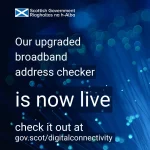Problems Remain as UK Broadband ISPs Mark First Year of One Touch Switching

Ofcom and the rest of the industry will later this week mark the first anniversary of One Touch Switching, which reflects the new system of easier and quicker UK consumer migration between home broadband and phone providers on different networks. But despite OTS making life easier for most people, some problems persist.
The OTS system, which finally went live on 12th September 2024 – after over 17 months of delays (here), remains a Gaining Provider Led (GPL) process, where the customer contacts their new (“gaining“) ISP to start and manage the process on their behalf. But unlike the old system, which was primarily geared toward switches on Openreach’s network, the new one expanded that to work across the UK’s increasingly diverse market of alternative networks.
In order to make this work, the industry established The One Touch Switching Company (TOTSCo), which is the organisation responsible for helping to implement Ofcom’s consumer OTS switching solution via a centralised messaging platform (hub). TOTSCo are also developing a separate solution for switching between business connectivity providers (due to go live in early 2026), but that’s another story (here).
Advertisement
The system does work and has already helped around 1.6 million consumers to switch broadband ISP since launch. But one of the biggest remaining challenges has flowed from the difficulty of getting the “matching process” to function properly, which exists to ensure that customer switches are correctly verified before being migrated. This is only successful if all the key data for a switch is correct, otherwise it can be rejected; this still happens quite a bit.
An Ofcom spokesperson told ISPreview:
“Since One Touch Switch came in, it’s never been easier to switch landline or broadband provider. And we’re pleased to see many people are taking advantage of the new process and switching to the provider that’s best for them.
There is, of course, always more that can be done to ensure the experience is as smooth as possible for customers and providers using the service. That’s why we’re continuing to monitor progress closely to ensure industry is tackling any issues swiftly.”
As it stands a total of around 342 brands (e.g. broadband ISPs), alongside various Managed Access Providers (MAPs), are now live on TOTSCo’s production directory and the daily switch match success rate is currently hovering around 67% – 68% (up from c.64% in January 2025). In addition, it should be noted that some failed switches will still get approved later, after corrections are made.
However, since we’re only a few days away from the OTS anniversary, we thought it might be interesting to dig into some of the problems that ISPs are still experiencing with this process. Some of the key ones have been listed below (unordered) and stem from off-the-record feedback from a variety of industry sources.
Problems with the OTS Switchinging Process
1. Some ISPs remain frustrated by the fact that a small number of internet providers are still not fully on-boarded with TOTSCo’s platform and that Ofcom have been slow to tackle this (causing problems for consumers and supportive providers). Customers with such providers may face downtime and other issues when trying to switch.
2. Some gaining providers are not completing the transfer confirmation process properly, which causes problems with billing for the losing provider (i.e. billing remains open) and annoyance for customers. The losing provider typically takes the flak for this, despite it being caused by the gaining provider.
3. Certain specific smaller providers always seem to fail an OTS request from a gaining ISP, often giving all sorts of questionable reasons in response. The suspicion is that they’re doing this not due to a fault, but to stop customers switching away (i.e. making it much harder for them to leave).
4. The current process seems to lack a clear trigger from the gaining provider to tell the losing provider which physical underlying broadband network they are going to put the new customer on. This is important because today’s market is awash with lots of alternative networks, but without this trigger it can be difficult to tell whether the switch is a straight migration or a new service provision – all of which has implications for the correct process to adopt and setup costs etc.
5. Some losing ISPs see gaining providers trigger the OTS process, but then never use it, leaving the switch details open. The gaining provider may later proceed to put orders and not link them. The ISP then of course loses complete tracking and again the losing provider takes the flack, when the gaining provider is the one making the mistakes.
6. One ISP called out a problem with Working Line Takeovers (i.e. where new customers move into a new property and want to takeover the existing line) – in that, they’re losing customers where it’s quite clear that they should have gone through OTS, but there is not a clear method for disputing these cease orders (so they’re not always able to contact the ISP in question as they’re not using the CP to CP tool). In cases like this the ISP needs to be able to report these providers for non-compliance, but they don’t know who they are.
In addition to the above, there are also a number of other issues that exist both inside and outside of the OTS process. For example, when Ofcom launched OTS they also banned notice period charges beyond the switch date for residential customers, which is intended to prevent situations where a customer ends up having to pay for two services at the same time. But a very smaller number of providers claim otherwise and seem to ignore the regulator’s updated rules.
Advertisement
So far as we can tell, most of the problems that remain are either related to issues with the process itself or seem to emanate from a very few specific providers, usually smaller players within the industry (albeit with the odd medium-sized ISP also causing some repeated issues). But it’s clear that the system today is in a much better place than it was when first launched a year ago, even if the edges are still in need of further polish.
Finally, we’ve also gathered a few comments from a mix of different providers across the UK’s broadband market.
Matt Kay, Finance Director, Zen Internet, said:
“We see One Touch Switch as a positive step for consumers. It makes moving between providers simpler, especially from networks not previously covered, and that’s the right thing to do. That said, we’ve seen some ongoing challenges with the matching process, which can add friction for customers.
Like many in the industry, we’ve felt the cost and complexity of implementation at a time when the sector is already managing big changes. And despite the benefits, we’ve not yet seen a dramatic uplift in the number of customers choosing to switch.
Overall, the principle is sound and when it works smoothly it improves the experience. We remain committed to making switching easier and would welcome further improvements across the ecosystem to make that the norm.”
A Hyperoptic spokesperson said:
“In most cases, the switching process is working smoothly and as intended. Customers can move between providers with minimal effort, and with the gaining provider managing the switch, we’ve seen greater customer confidence and a more reassuring onboarding experience — in particular that they won’t be left without broadband.
That said, like any complex industry-wide process, there are occasional exceptions —especially when issues arise from other providers. Resolving these can be challenging, and while the CP-to-CP portal was designed to help, it hasn’t proven as effective in practice as we’d hoped. As a result, we’ve found it necessary to invest additional operational support to proactively manage risks and ensure a consistently smooth experience for customers. We’re continuing to work with industry partners to improve this aspect of the journey.”
An EE spokesperson said:
“We’re very supportive of One Touch Switching and the improved experience it offers our customers. We’re committed to further improving match success rates, working closely with the rest of industry, to bring the benefits of One Touch Switching to as many customers as possible. For the small proportion that can’t be matched, we’ll continue to work hard to ensure moving providers is as easy as possible for them.”
Simon Davies, iDNET’s Director, said:
“In general we are pretty happy with OTS. It would have been much simpler if it had been enacted at the network level rather than the billing level but it is what it is.”
A TalkTalk spokesperson said:
“TalkTalk supports One Touch Switch because it makes it easier for customers to change broadband providers, particularly between different networks. It’s one of the biggest regulatory changes introduced by Ofcom and, as a result, has required major investment from larger and smaller broadband providers to implement. Customers are adapting to changes in the sales journey but we look forward to a collaborative effort from the telecoms industry to further simplify the process for customers and enhance their understanding of the steps required.”
We’d of course welcome any feedback in the comments below from people who have switched ISP this year and how you found the experience.
Mark is a professional technology writer, IT consultant and computer engineer from Dorset (England), he also founded ISPreview in 1999 and enjoys analysing the latest telecoms and broadband developments. Find me on X (Twitter), Mastodon, Facebook, BlueSky, Threads.net and Linkedin.
« Gov Change DSIT Secretary and Leaves UK Telecoms Minister Role Vacant
Advertisement
Leave a Reply Cancel reply
Privacy Notice: Please note that news comments are anonymous, which means that we do NOT require you to enter any real personal details to post a message and display names can be almost anything you like (provided they do not contain offensive language or impersonate a real person�s legal name). By clicking to submit a post you agree to storing your entries for comment content, display name, IP and email in our database, for as long as the post remains live.
Only the submitted name and comment will be displayed in public, while the rest will be kept private (we will never share this outside of ISPreview, regardless of whether the data is real or fake). This comment system uses submitted IP, email and website address data to spot abuse and spammers. All data is transferred via an encrypted (https secure) session.























































68% matching rate? Can someone please explain to me why they couldn’t implement a PAC code like with telephone number migrations and have a 100% matching rate?
Ofcom took the view that the PAC method, which was more intended for mobile operators – all of which work and are set up in a fundamentally similar way, was not as simple for the consumer as OTS. Switching between physically separate broadband networks via PAC would have also involved more effort on the part of the end-user, sometimes quite a bit more to cover different scenarios and technologies.
It might have meant a bit more effort on the consumers part but would have still been preferable to a 1 in 3 failure rate. I’m wanting to switch in 2 months time but stories like this hardly inspire confidence.
The Mac system aka Pac is clearly the best way, as this is not quick and convenient for a 1/3 of customers. Plus this method is too vulnerable to hijacking, it offers no opt out mechanism.
the reason a PAC was not workable is that unlike mobile where every customer has a mobile, in fixed there is a substantial minority who do not. A PAC type system was looked at but it would have meant sending letters out by post to those who do not have a mobile and this meant it was completely unworkable. The system has to work for all. ANd as has been said the matching rate quoted here is for the first attempt only, once errors get fixed the success rate is much higher.
PAC codes work so much better when there are rules in place requiring them to be given out on request, without needing to talk to retentions. Almost all ISPs have a portal where you can upgrade, but few allow for downgrades or back in the day PAC codes….
“And despite the benefits, we’ve not yet seen a dramatic uplift in the number of customers choosing to switch.” – Zen
I don’t expect they ever will. Similar schemes for current accounts and energy retailers did next to nothing for switching rates. Not that these switching schemes aren’t important, the minority of people who do switch help shape the market for everybody.
A 1 in 3 failure rate after a year? Absolutely pathetic. That alone would probably deter many customers from switching. As GreenLantern22 says it might have been better to implement something similar to the text for PAC system now used on mobiles.
We’re a smaller ISP, and we’re constantly frustrated by OTS. We went down the MAP route (so someone handles the technical implementation for us) but the entire system felt crude, and the process of getting our data into the system was frustrating. They then put their prices up an obscene amount – the cost of registering each customer with them for OTS was in the tens of pounds per customer per year.
We switched MAPs, and are finding incomplete APIs to get our data into the system making everything more manual than it needs to be. Every time we experience an issue such as a none-response from the losing provider the MAP says “Speak to TOTSCO”.
These MAP providers also make it really hard to even give the customer a list to select from for who their current provider is, we just have to ask them to type their provider in.
It’s an absolutely frustrating experience, so we’re instead (with the help of RevKs’ excellent notsco tool) implementing our own version, as opposed to trying yet another MAP provider. However we then end up paying more for the “Subscription” price being direct as opposed to via a MAP.
Seems like you got unlucky in choosing a MAP’s. Ours has been excellent, responsive and has provided the necessary API endpoints when requested, together with full reporting. Whenever we’ve had issues that would involve TOTSCo, the MAP has sorted that for us.
Hi.
Not too difficult to work out who your current MAP is . If you’d like a solution that actually works for half the price, try http://www.zentive.com/one-touch-switch
We used a MAP and to be fair zentive have been pretty good. As above we have reporting etc, it would just be good if everyone had to be registered with the cp-to-cp tool.
We’re a small ISP using our own implementation. The biggest issue we see is almost all the match requests we get are not even for us! And we’re talking probably 90% ‘failure’ here.. Every failure is reviewed by a human afterwards and it’s ‘not us’. So the stats need a pinch of salt.
A family member was originally with Shell, got moved to TalkTalk and now to Utility Warehouse. Tried switching him to Vodafone but his details do not match neither TalkTalk nor Utility Warehouse when using the One Touch System; literally have no idea how to move him without him losing his phone number…
Just started moving from BT to CF – experience so far has been smooth but we’re hoping that the 12 working days to get the landline number ported is a significant overestimate.
It’s not great considering BT’s phone provision relies on its broadband – ideally it would continue until the port was complete.
Amusingly BT’s renewal offer for our 500/70 service dropped by £6/month just after we started the switch. If they’d offered that before, maybe we would have taken it. Hard to argue with 2.5->5Gbps sync. for £39/mo. Would have gone lower if that didn’t mean CGNAT.
mmm,
Now why not concentrate on improvign poor service naf having reasonable prices, then there’d have been no need for OTS, the costs and efforts of many for no real service improvement – well don Ofcon – add costs for symptom wastage rather than problem solving – set a level for service and revoke operator licences for failures – even fine the boards of bad providers, and perhaps bad regulators 🙂